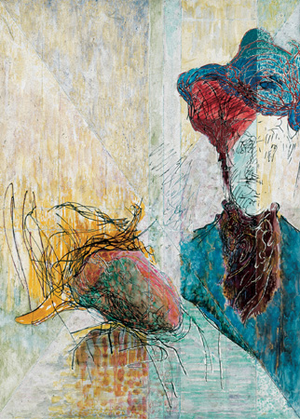Ilka Gedö studied arts at non-official painting schools. The drawings she made in the Budapest Ghetto in 1944 offer a striking account of the distress and suffering endured by Jews (Self-Portrait in the Ghetto, 1944). After the war, creating a huge number of drawings, she turned to drawing thematic series (Ganz Factory Drawings, Self-portraits, Self-Portraits in Pregnancy, Tables), but gave up artistic activity between 1949 and 1965. She wrote a study on the art of Lajos Vajda in 1954, and she translated Goethe’s Theory of Colours into Hungarian. Her second period was marked by the elaboration of a very specific method: starting with sketches depicting ideas or feelings, she then transposed them onto canvas, enlarging them proportionally, with all their details. Her best pieces, among others, the Rose Garden and Artificial Flower Series in the 1970s, mostly rely on the use of figurative motifs (Edina, 1971). I. Gedő died at the age of 64, a few months before her discovery abroad. The scene of the breakthrough was Glasgow where the Compass Gallery presented her paintings and drawings in 1985. This was followed by a major retrospective at Glasgow’s Third Eye Centre at the turn of 1989-1990.
Katalin GELLER
See this illustrated text on the website of the Archives of Women Artists, Research and Exhibitions
